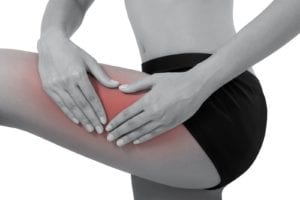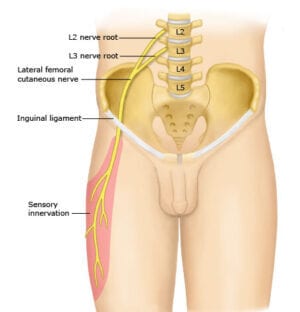The term Meralgia Paresthetica comes from four Greek roots and means “ thigh pain with anomalous perception”. The Greek terminology is an apt description of a very common and debilitating, but little known cause of thigh pain. Meralgia Paresthetica more commonly occurs in middle aged persons and diabetics, and is an often underdiagnosed source of pain.
What are the symptoms of Meralgia Paresthetica?
A person typically presents with sudden onset of symptoms that occur without known injury including burning, numb and tingling in the upper lateral (outer) thigh, that can be quite painful. These thigh pain symptoms are usually increased with standing and walking, laying down on their back with legs outstretched and decreased with sitting. Meralgia Paresthetica usually affects one thigh only but it can be present on both sides 20% of the time.

Anatomy of Meralgia Paresthetica
The condition is caused by focal entrapment or irritation of the Lateral Femoral Cutaneous Nerve (LFCN), a sensory or feeling nerve branch that provides sensation to the front and outside of the upper thigh. The LFCN originates from a group of nerves in the lumbar spine called the lumbar plexus and then passes through the inguinal ligament where it exits to the upper part of the thigh muscle.

What Causes Meralgia Paresthetica?
Many times there is no identifiable cause of the condition, but compression of the nerve can occur from wearing a heavy utility belt in construction workers, police officers and the military and seat belt injuries from a lap belt. Other potential causes include pregnancy, obesity and wearing tight fitting clothing hence the term “skinny jeans syndrome”. Additional considerations for compression of the LCFN include lying in the fetal position for prolonged periods.
Other Conditions that may present similarly
Other conditions that should be ruled out that may cause similar pain and symptoms in the outer upper thigh include lumbar spine disc disease which can cause nerve root irritation, referral pain from arthritis of joints in the lumbar spine called facet joints, and hip joint conditions including labral tear and arthritis.
How is Meralgia Paresthetica diagnosed?
The condition that commonly causes thigh pain is usually diagnosed by a thorough history and physical examination, as well as ruling out other potential similar actors. A nerve conduction study that tests the nerves and muscles in the lower extremities can be utilized to rule out lumbar spine nerve pain as well as MRI of the lumbar spine to rule out disc and nerve root impingement.
Treatment of Meralgia Paresthetica
Treatment of this condition can be approached in several ways. Oral medications include pain medications, anti-inflammatories including NSAIDS and a short course of steroids and neuropathic medications. Note that oral medications may be suboptimal at alleviating the painful condition and may have side effects.
Other treatment options include ultrasound guided injection of the LFCN with steroid and anesthetic to reduce irritation of the nerve and potentially de- adhese the nerve from surrounding tissue by fluid injection. If the nerve block offers only short term relief of pain, another procedure called Radiofrequency Neurotomy (or Radiofrequency Ablation) may be performed. This procedure is where the nerve branch, because it is a sensory nerve only, is essentially heated up or cauterized to stop the pain signal. This is a safe procedure that may offer relief for up to a year but effectiveness is variable.
Treatment of the Lateral Femoral Cutaneous nerve with a serum made from your own platelets called Platelet Lysate may also be effective. Physical therapy is another treatment method that may be beneficial in alleviating pain as well.

Michelle Hall
PA-CPhysician Assistant




